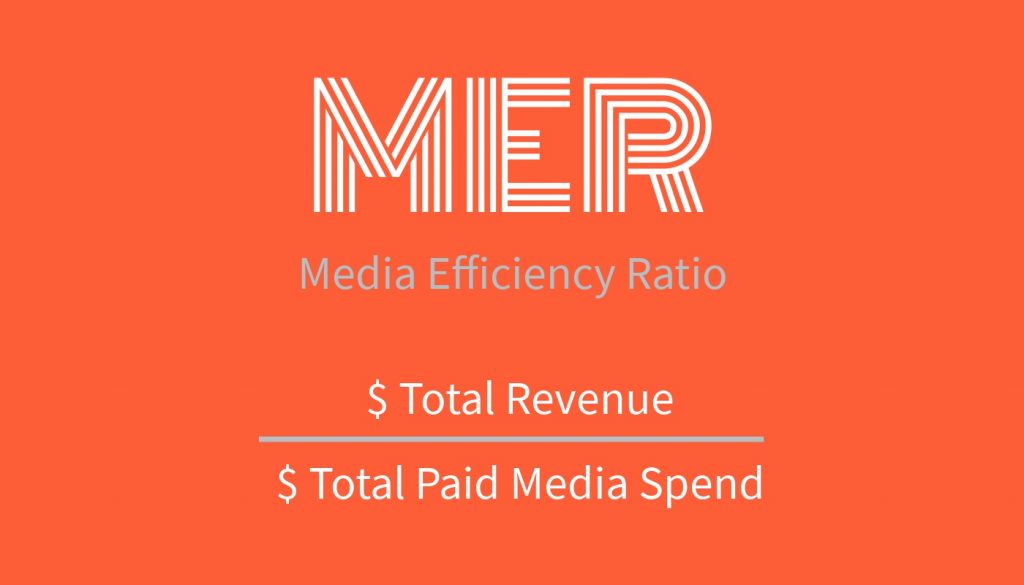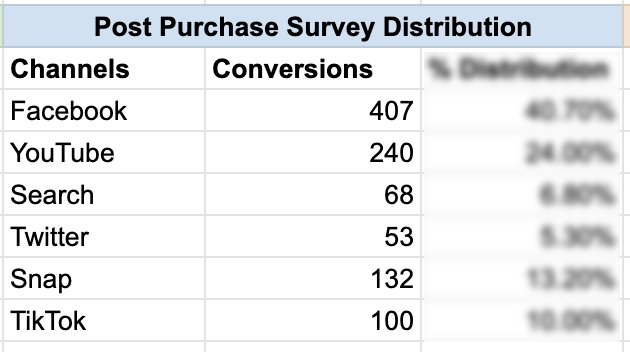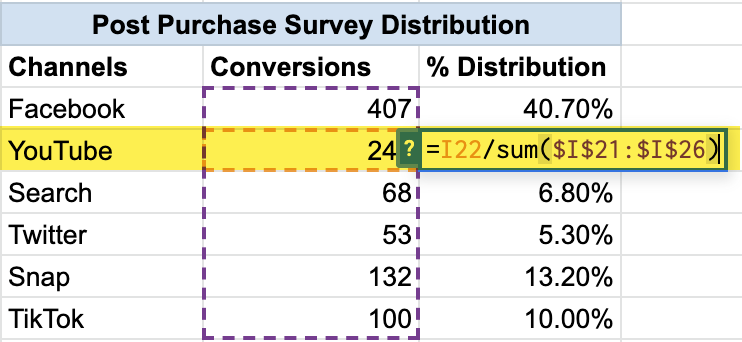Media Efficiency Ratio [MER] – A Growth Metric
Written by: Gabriel Solberg Read time 5 minutes
Media Efficiency Ratio or MER is a marketing metric to measure how efficiently paid media is driving total revenue.

In e-commerce, the Media Efficiency Ratio is often referred to as Blended ROAS. Return on ad spend (ROAS) and Media Efficiency Ratio are not the same. ROAS only measures the efficiency of campaigns that can be directly attributed to revenue. On the other hand, MER measures efficiency for all money spent on paid advertising as a ratio to all revenue across the business.
Both terms Media Efficiency Ratio and Blended ROAS have the same definition. It’s a simple formula that can be used to measure the ratio of how efficiently marketing spend is driving overall revenue for a business.
How do you calculate the Media Efficiency Ratio or Blended ROAS in digital marketing?
To calculate your Media Efficiency Ratio divide the total revenue / total paid ad spend from all channels.
Media Efficiency Ratio for Growth
For growth MER is a critical metric. If you are only looking at last-click conversions you will quickly hit a point of diminishing return on paid efforts. To maintain growth, channel expansion is a must. However, not all channels can be directly attributed to impact. Redistributing conversion impact using post-purchase survey data measures the impact of non-last-click channels which can then be measured using the Media Efficiency Ratio.
Before we look at how you can use post-purchase survey data in conjunction with the Media Efficiency Ratio, in the context of digital marketing, let’s take a look at how the ratio is used in traditional media.
Media Efficiency Ratio in Traditional Advertising
Let’s take billboards, a traditional OOH (Out Of Home) media buy, as an example. Say we are planning to spend $100,000 for a billboard campaign that will run for 14 days in city X. By measuring foot and car traffic we can get an estimated number of people that will be exposed to our ad for the lifetime of the campaign. This can easily translate to a number of estimated impressions. If we are spending $100,000 for a 14-day billboard campaign with an estimated CPM of $500 our ads will be seen or exposed to ~14,000 people each day and ~200,000 impressions for the lifetime of the campaign.
How can we measure the efficiency of this campaign?
The question is: How can we measure the efficiency of this campaign? There is no form of tracking that tells you if someone saw the billboard right before making a purchase or how the billboard influenced any future purchases.
This is where the Media Efficiency Ratio comes into play. To understand if the campaign worked we take the total media spend for city X and divide it by the total revenue generated by city X to get the Media Efficiency Ratio. The stronger the MER ratio the more successful the billboard campaign was in driving increased revenue for the business.
This is an oversimplified example to illustrate the application of the Media Efficiency Ratio. Naturally, measurement can get more complex as you expand your media mix and add in additional channels such as linear TV or digital campaigns.
Why The Media Efficiency Ratio Makes Sense for Digital Advertising
I am going to go ahead and say it. A perfect cross-channel attribution tool does not exist. As a result of the walled garden effect and the increase in recent privacy updates from the two tech giants, Apple and Google, there will never be a deterministic cross-channel attribution solution. Facebook was able to target people and not cookies over a 28-day window for better attribution measurement (although restricted to Facebook’s walled garden) until the iOS 14 Privacy Update rolled out in the spring of 2021.
However, there are ways you can measure the success of your digital advertising campaigns and leverage the Media Efficiency Ratio as an actionable metric. MER can also provide a good understanding of media spend, in relationship to business revenue, and give you a solid grasp on customer acquisition trends.
Limitations of the Last-Click Attribution Model
In the early days of digital marketing using a last-click attribution model was the industry favorite. The reason being? It was simple, deterministic, and easy to measure. The last-click reporting methodology can tell marketers which specific campaign, audience, placement or ad-generated conversions.
However, marketers quickly realized that relying solely on a last-click attribution model does not account for the complete customer journey. Cross-channel and cross-device touchpoints drive consideration and decision-making in a consumer’s path to purchase. Leaning into and understanding these touchpoints is critical, especially with scale, or growth will remain restricted.
This is where using the Marketing Efficiency Ratio can help you understand the overall efficiency of your media spend in relation to business revenue growth.
Making Media Efficiency Ratio Actionable
The Media Efficiency Ratio only gives you a birds-eye view of performance. It’s a great indicator of how media spend impacts business revenue growth. However, since MER is a directional measurement metric it’s harder to make the data actionable outside of saying “Hey, we spent more and there is correlating revenue growth.”
Let’s take a look at some things you can do to make the Media Efficiency Ratio an actionable metric using post-purchase survey data.
The Value of Post-Purchase Surveys
It is good practice to run an ongoing post-purchase survey. By asking customers where they heard about your brand or product you can understand:
What channels are responsible for indirectly driving the most conversions.
What channels drive the highest impact on product/brand consideration
Note: For post-purchase surveys make sure you use a randomized list of options or a free-form field to avoid selection bias.
Ok, that’s great. Now we are collecting customer feedback. What can we do with it?
Leveraging Post-Purchase Survey Data to Measure Impact
We can directionally calculate channel conversion lift using post-purchase survey distribution percentages. The redistribution of conversions across channels can help identify where your media budget has the highest impact on revenue growth. Running this analysis can also help avoid cutting budgets for channels where you are not seeing last-click performance even though your Media Efficiency Ratio is positive. Think YouTube.
First, pull cost and last-click conversion data. Then group these by channel. You can pull this data directly from the ad platform or to get a true last-click view pull the data from Google Analytics.

Next, pull your post-purchase survey data and organize your results by channel. Typically this is the ‘Heard from’ field. Pivot your survey responses by the channel or ‘Heard from’ field and sum the count of conversions for each row.

Now add a % Distribution column. The formula takes the conversion for a specific row/channel and divides it by the total number of conversions.

This will give us the post-purchase survey conversion distribution in percentages on the channel level.

Now redistribute last-click conversions by multiplying your total last-click conversions by the post-purchase survey % Distribution for each row/channel.

You can now better understand the relationship between last-click and non-last-click conversions. For example, conversions under Estimated Channel Lift tell us what channels are responsible for indirect conversions and drive product/brand consideration. If we lean into these channels we should see our Media Efficiency Ratio improve over time.

Running this analysis can give us insight into budget allocations across channels without making short-sighted and reactive decisions.
Conclusion
Directional data analysis in conjunction with the Media Efficiency Ratio can inform our strategy across channels in a post-privacy world.
If we want to achieve growth we need to rely less on deterministic data and start thinking holistically about the customer journey across the digital ecosystem.
MER and more importantly being able to optimize for your Media Efficiency Ratio is critical for any brand or product to achieve growth through paid digital advertising.
How have you leveraged the Media Efficiency Ratio for the growth of paid channels?
AUTHOR BIO:

With over a decade of digital marketing experience, Gabriel excels in search, display, and social advertising across various industries. He specializes in performance media and data-driven storytelling, building custom digital ecosystems that enhance user experiences across both paid and owned channels. Connect with Gabriel on LinkedIn or explore more of his articles here.
Leave a comment